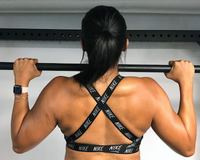
The Nordic Hamstring Curl
Also known as the leg curl or the natural glute-ham raise, the Nordic hamstring curl is one of the best exercises to strengthen your hamstrings. You can perform this exercise with a partner or with the help of some simple equipment.
The Nordic hamstring curl is a versatile exercise that can help you build bigger, stronger legs!
Muscles Worked By The Nordic Hamstring Curl
Primary Muscle Groups:
The hamstrings are the primary target muscles of the Nordic hamstring curl.
A group of three muscles combine to form the hamstring: the biceps femoris, semitendinosus, and the semimembranosus. The Nordic hamstring curl helps to build all three of these muscles in the back of your leg.
Building muscle in your hamstrings is one of the best ways to improve your overall explosiveness and lower body strength.

Secondary Muscle Groups:
The Nordic hamstring curl secondarily engages your gluteal muscles, (gluteus maximus, medius, and minimus) lower back (spinal erectors) and upper back (rhomboids).
Throughout the Nordic hamstring curl, your glutes help to stabilize your lower body and your lower and upper back activate to stabilize your upper body.
Nordic Hamstring Curl Benefits
1. Size And Strength Gains
The Nordic hamstring curl builds leg size and strength without the use of heavy weights. As a result, the Nordic hamstring curl can act as a supplementary exercise to help you improve your performance in weight-bearing exercises like the squat and deadlift.
Whether you are an athlete, bodybuilder, or simply someone who values fitness, this exercise will certainly help you build bigger, stronger hamstrings.
2. Injury Prevention
The hamstrings are one of the most injury-prone muscle groups in the body. A strained hamstring can sideline even the best athletes for weeks at a time. However, adding the Nordic hamstring curl to your training can reduce your risk of injury.
According to a systematic review and meta-analysis of 8459 athletes found that adding the Nordic hamstring curl to workout programs reduced injury occurrences by 51% (1).
The Nordic hamstring curl is an eccentric exercise, which means the hamstrings activate as the leg muscle increases in length. This helps to build a more stable hamstring, which may explain why this exercise prevents future injuries to the hamstrings.
3. Improved Vertical Jump And Speed
Your glutes and hamstrings are key muscles involved in both running and jumping. Their development is crucial to improve your vertical jump and your sprinting speed. With consistent hamstring training, you will undoubtedly see improvements in your explosiveness and athletic performance.
How To Do The Nordic Hamstring Curl
Equipment:
The Nordic hamstring curl can be performed without any equipment at all. If you have a partner, they need to hold your ankles in place.
However, if you are alone, find a cable pulldown machine, a couch, or anything a few inches off the ground that can support your ankles. You may also want to use a towel or something soft to support your knees!
Setup:
a) Begin by kneeling on both knees with your back straight.
b) Secure your ankles with a piece of equipment or have your partner hold them in place.
Action:
a) Tighten your hamstrings, glutes, and abs.
b) Keeping your back straight, slowly lean forward until you reach the floor. *Note — most people cannot control the movement all the way down. Lean forward as far as you can until you fall forward and catch yourself.
c) Squeeze your hamstrings to raise your body back to the starting position. Feel free to push yourself up off the ground if you need an initial boost!
d) Squeeze hamstrings and glutes hard at the top to maximize contraction. Repeat!

Recommendation:
This exercise can be difficult for experienced weightlifters, let alone beginners. Once you’ve mastered the Nordic hamstring curl, aim for three sets of six to ten repetitions. For those who want a greater challenge, keep reading for more variations!
Common Nordic Hamstring Curl Mistakes
1. Rushing The Movement Downwards
Many lifters tend to simply fall to the ground quickly and push themselves back up during the Nordic hamstring curl. While this exercise is challenging, rushing through the motion will not build any muscle in the hamstrings or glutes.
Try to lean forward as slowly as possible before falling downwards to maximize time under tension during the Nordic hamstring curl.
2. Bending Too Much At The Hips
Many lifters often bend their waist forward as they raise their body from a horizontal position. This likely occurs due to a lack of strength in the hamstrings, as bending moves tension away from the hamstrings.
A slight bend at the hips is normal during the Nordic hamstring curl. However, over-bending will prevent you from seeing the maximum gains in your hamstrings. Instead, practice proper form with a variation to make the exercise easier!
3. Hyperextending The Back
After bending downwards to reach the point at which the body is parallel to the floor, many people have the tendency to hyper-extend their back as they raise upwards. A hyper-extended back during the Nordic hamstring curl simply occurs due to a lack of strength in the hamstrings.
If you feel major lower back tension during this exercise, you are probably hyper-extending your back. Don’t be discouraged! The Nordic hamstring curl is a difficult exercise. With steady practice, you will master the form in no time.
Nordic Hamstring Curl Variations
1. Banded Nordic Hamstring Curl
To make the Nordic hamstring curl a bit easier, try using a resistance band. Attach the band on an elevated hook or piece of equipment and hold the band with your hands close together above your head.
The band will provide an assisting force to help you to master the form and do more reps as you are beginning to build hamstring strength.

2. Weighted Nordic Hamstring Curl
If you have already mastered the body weight version of the Nordic hamstring curl, try adding some resistance in the form of dumbbells or a weighted vest.
However, make sure to choose a form of resistance that still allows you to use your hands if you need to push yourself off the bench/ground!

Nordic Hamstring Curl Alternatives
If you enjoyed the Nordic hamstring curl, check out these other hamstring exercises to bolster your lower body training:
1. Glute-Ham Raise
Position your feet firmly against the foot plate of a glute-ham raise machine and allow your calves to press against the ankle hooks. Your knees should be slightly behind or exactly on the knee pads. Start with your upper body perpendicular to the ground. Feel as though you are able to draw a vertical line from your head to your knees.
Slowly lower yourself until your body is parallel to the floor. Next, press your toes into the foot plate and raise your body using your hamstrings (and some help from your glutes). Squeeze hamstrings and glutes hard at the top to maximize contraction.

2. Lying Leg Curl
Lie on your stomach and plant your elbows on the ground to support your upper body. With your legs outstretched, place a dumbbell in between your feet. Squeeze your feet together to secure it in place. Then, contract your hamstrings to bring your feet towards your buttocks. Slowly return to the starting position and repeat!

3. Standing Tension Leg Curl
Assume a standing position. Place one foot behind the other with your heel off the ground. Contract your hamstring to bring your trail foot towards your buttocks. Slowly return to the starting position and repeat!

Looking For A Complete Hamstring Workout?
Try out this intense 5-minute at home hamstring workout!
Join the Invasion!
This Anabolic Aliens membership will grant you access to workout classes, rehab programs, diet plans, and more exclusive content to help you achieve sustainable success!










